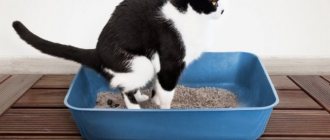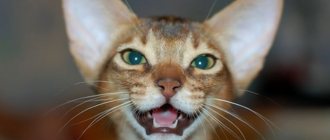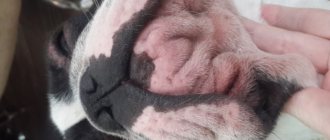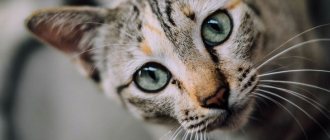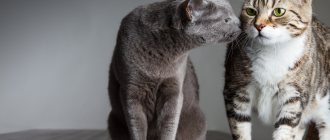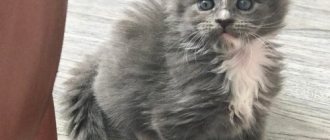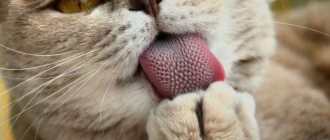Should I worry?
Nosebleeds are an alarming symptom, but you should not panic. The animal needs to be calmed to reduce its blood pressure, which rises when overexcited.
Isolated cases and constant phenomena
If bleeding occurs regularly in an animal, this is a reason to urgently consult a veterinarian. It is important to find out whether the condition is accompanied by other problems: internal bleeding, lethargy, black stool.
In isolated cases, an animal's nose may bleed after playing with another pet or receiving injuries. Poisoning with rat poison is also accompanied by bleeding.
It is important to keep all chemicals in closed cabinets.
First aid
Before the doctor arrives or goes to the clinic, it is necessary to stop the bleeding at home.
The animal is calmed down, an ice pack is placed on the bridge of the nose, after wrapping it in a towel. Such a bundle should not make it difficult for your pet to breathe. Under the influence of low temperatures, blood vessels narrow and bleeding stops.
When is veterinary help needed?
If the owner cannot stop the bleeding using available methods, it is necessary to contact a veterinary clinic.
Regularly recurring bleeding should not be ignored. In this case, the help of a specialist is needed.
Preventing runny nose in pets
To eliminate most causes of runny nose in cats, you need to:
- limit your pet’s contact with stray animals;
- exclude access to potential allergens;
- provide the animal with a warm, dry resting place without drafts;
- do not neglect vaccination and deworming;
- support your pet’s immunity and take care of its proper nutrition.
It is quite possible to cure a runny nose in a cat on your own, but only after mandatory consultation with a doctor. If treated promptly, a specialist can identify the cause of an animal’s nasal discharge and prescribe appropriate therapy. A caring and responsible owner should closely monitor any changes in the animal’s behavior - therapy for pathology identified at an early stage will be simple and most effective.
Causes of bleeding from the nose
The nasopharyngeal mucosa contains a large number of blood vessels. Its injury leads to the release of drops of blood. This can happen during a fight with another cat or dog, sniffing plants with thorns, or after falling from a height.
Other reasons:
Foreign body in the nasal passages: most often these are the remains of plants or cereal grains. A veterinarian will be able to detect the object during rhinoscopy.- Tumor. The neoplasm does not make itself felt at first. Later, heavy bleeding appears due to tissue rupture. You can suspect such a problem if the nose is swollen, the shape of the back has changed, or the muzzle as a whole is deformed. This pathology is more common in older cats and almost never in young cats and newborn kittens.
- Inflammation in the oral cavity can also provoke blood flow. Most often this is a tooth abscess.
- If your cat produces blood when sneezing, clots of mucus appear, a bacterial or viral disease is suspected.
- An increase in pressure provokes a rupture of capillaries, and blood comes out.
Decreased blood clotting is manifested by heavy bleeding, including nosebleeds.
Preventive actions
In this article, we were able to find out why a cat sneezes blood (blood from an animal’s nose when sneezing can be a really serious symptom). But first of all, this can happen due to the presence of allergens in the house or dust getting into the animal’s nasal passages. Therefore, wet cleaning should be carried out frequently using safe cleaning products.
And to exclude dangerous diseases, it is necessary to carry out timely vaccination. Starting from six months, you should follow the established schedule of vaccinations, carrying them out against rabies, leukemia and leukopenia, and cat flu. The main thing is that regular preventive examinations are carried out by an experienced veterinarian who will be able to detect impending danger in time and begin treatment in time.
Don’t wonder why your cat is constantly sneezing. You need to hurry up and help your furry friend.
Main symptoms
Diseases accompanied by bleeding from both nostrils have a number of symptoms. By observing the animal, you can accurately determine the cause of this condition.
Decreased clotting
Some chronic diseases lead to this condition: viral leukemia, immunodeficiency, the effect of non-steroidal anti-inflammatory drugs, liver failure.
Symptoms: red spots on the gums, ears, pallor of the oral mucosa, lethargy, apathy.
Pulmonary hemorrhage
When lung tissue is injured, breathing and circulation are impaired. Most often, the liver suffers, causing a decrease in blood clotting.
Symptoms: moderate to severe nosebleeds, shortness of breath, lethargy.
Nasal infections
If the animal sneezes blood or mucus comes out of the nose, a viral or bacterial infection is suspected.
Parasites
All types of blood-sucking insects and helminths lead to a decrease in platelet levels, resulting in impaired blood clotting.
Intoxication
When poisonous substances enter a cat's body, it is accompanied by internal bleeding. This condition is often observed during intoxication with rat poison.
An animal can become poisoned by eating a poisoned rodent or in another way if the poison is in a place accessible to the animal.
First aid for nosebleeds
The appearance of blood from a cat's mouth or nasal passages leads the owner of the animal into a stupor or panic. It is necessary to calm down and carefully examine the pet, thus assessing the severity of the situation.
Next, it is important to calm the pet as much as possible, which will normalize blood pressure and prevent increased bleeding. You should not give your cat human sedatives on your own without first consulting a specialist.
Severe bleeding from the cat’s nose must be stopped by applying a cold compress to the back of the animal’s nose, and then taken to the clinic.
In a clinical setting, the animal will undergo a comprehensive clinical examination to make an accurate diagnosis and prescribe adequate treatment. Diagnosis of nosebleeds includes several laboratory tests:
- blood biochemistry;
- cytological examination;
- general blood analysis;
- urine analysis (to assess the functioning of the kidney structures).
A more thorough examination includes endoscopy (if gastric blockage is suspected), x-ray examination of the sinuses, rhinoscopy and computed tomography. Additional diagnostic methods include conducting serological tests if a fungal infection or disease caused by ticks is suspected.
Diagnostics
The examination is aimed at identifying the cause of ill health.
Diagnostics is carried out comprehensively. This can only be done in a veterinary clinic.
What questions will the veterinarian ask?
It is important for the pet owner to remember all the symptoms that accompany bleeding in a pet.
At the clinic, the veterinarian clarifies the following:
- what medications does the cat take?
- are there toxic substances in the house;
- whether the pet was walking unattended;
- presence of injuries;
- what symptoms accompany bleeding: sneezing, vomiting, bloody diarrhea, difficulty breathing;
- does the pet rub its nose with its paw?
blood is discharged from one nostril or from both;- what is the condition of the animal’s oral cavity, the presence of diseased teeth, blood residues, changes in the color and structure of the gums;
- the presence of subcutaneous hemorrhages, bruises, hemorrhages;
- whether the animal has had a noticeable change in the shape of its muzzle, nose, whether the eyeballs are symmetrical, whether there is discharge from the eyes.
Accurate answers will help the veterinarian clarify the situation and partially determine the cause of deterioration in health, accompanied by nasal discharge.
Types of diagnostics
To determine the causes of bleeding, a series of clinical tests, radiography, and rhinoscopy are prescribed.
Blood tests
A complete blood count is indicated to determine platelet levels.
A urine test is carried out to determine the general condition of the body and the presence of inflammatory processes. This test also helps evaluate kidney function.
A biochemical blood test shows how the internal organs function and whether blood clotting indicators are normal.
Tests
Serological tests are performed to detect fungal and other infections.
X-ray
An X-ray examination of the nose allows you to assess the condition of the roots of the teeth, sinuses, the presence of a tumor, and the degree of destruction of cartilage tissue.
Nasal examination
Using rhinoscopy, the nasal passages are examined, the presence of foreign bodies is determined, and they are removed.
Sanitation of the oral cavity
When examining the teeth, teeth are cleaned, paying special attention to the root area, since inflammation of the tooth root affects the nasal sinus.
Biopsy
If traces of a tumor are noticed on an x-ray, part of the damaged tissue is taken for examination. A tissue biopsy helps determine the malignancy of the tumor.
Surgical method
It is used if it is necessary to remove a hard-to-reach foreign body in the nasal passage or take part of the tissue for a biopsy. The method is traumatic, the intervention is performed under anesthesia.
Mr. Cat warns: associated symptoms
Signs indicating that the animal urgently needs to be taken to the veterinarian:
- Sneezing is accompanied by bleeding.
- Periodontal disease or gumboil occurs.
- An unpleasant odor appears from the oral cavity.
- There are breathing problems.
- Lost appetite.
You should also pay attention to where exactly the blood is coming from. In some cases, it may not be the nostrils, but a wound caused by a broken tooth. Such damage occurs in the event of severe injuries such as falls or being hit by a car.
The fact that the problem is long-standing and advanced is also indicated by the animal swallowing blood.
Help an animal
Treatment for bleeding depends on the test result. If an animal is diagnosed with an infectious disease, a course of antibiotics is prescribed; for fungal infections, fungicidal drugs are prescribed.
If you have high blood pressure (hypertension), appropriate medications are prescribed to lower it.
Complex injuries, deformation of the nasal passages, and neoplasms are treated only surgically. A deeply stuck foreign object is removed with surgical instruments using anesthesia.
In case of poisoning with rat poison or hemophilia, vitamin K is indicated. Vasoconstrictor drugs and Adrenaline are injected into the nasal cavity.
For nosebleeds, symptomatic treatment and the use of drugs that promote blood clotting are indicated.
Traditional methods
If parasites are the cause of your pet's nosebleeds, they need to be removed. A decoction of tansy helps against fleas. It is used to rinse the animal's fur after bathing. In other cases, folk remedies are powerless.
At home, stop bleeding by applying cold to the back of the cat's nose. It is impossible to treat a pathology without knowing the cause. Wrong actions of the owner can cause the development of irreversible consequences.
The animal needs specialist consultation, a complete and comprehensive examination, and complex therapy.
How to treat a cat for sneezing?
Examination of a cat at the veterinarian
Any treatment must be prescribed by a doctor. This will depend on the reason that provokes this sneezing. If the veterinarian does not find any diseases in the animal, he may recommend the use of regular house cleaning or a special air humidifier.
If a cat has respiratory tract diseases, the animal will need nasal medications to eliminate swelling. If the case is much more serious, it will be necessary to undergo a course of treatment with antibiotics. If necessary, the veterinarian will prescribe surgery. The owner of the animal, who has found out what happened to his pet, must follow exactly all the recommendations of the specialist and do everything he says. After all, it is necessary to carry out the prescribed procedures in a timely manner. The veterinarian may prescribe tablets, injections, or nasal drops.
But when taking care of your pet furry, you must also maintain personal hygiene. If necessary, use gloves and a protective mask.
If no pathologies are detected
In order not to provoke a new attack, the animal is protected from stress. This helps stabilize emotional levels and pressure.
You cannot leave a cat on the street unattended: it can suffer from the actions of street animals, damage the nasal mucosa from hard leaves and thorns of plants, and their seeds.
It is important to undergo regular veterinary and dental examinations . This will prevent the development of inflammatory processes.
A nutritious diet with the introduction of vitamin complexes is the best prevention of anemia and a decrease in the level of platelets in the blood.
The relationship between bleeding and periodontal disease
It is common to experience bleeding due to dental disease. This is explained by the fact that the upper jaw bone of a cat is quite thin, and the roots of the fangs are located at great depths. Therefore, if inflammatory processes are present in them, their products can enter the nasopharynx. In this case, the disease also affects the blood vessels. This causes bleeding.

